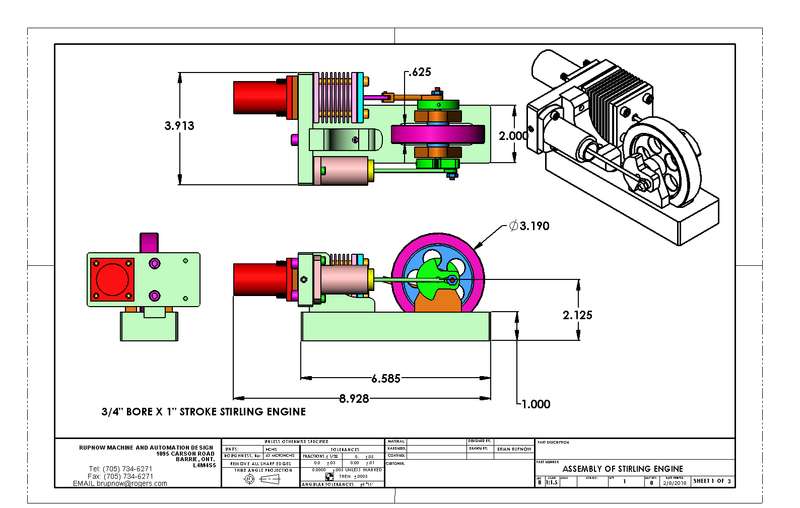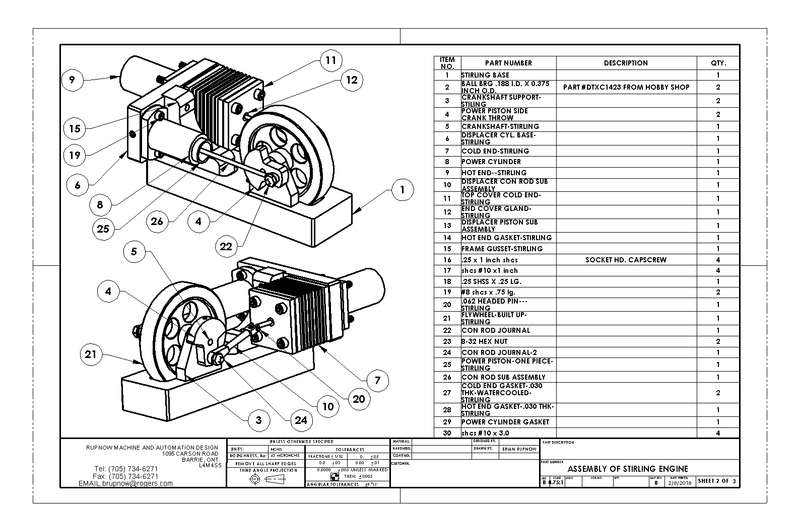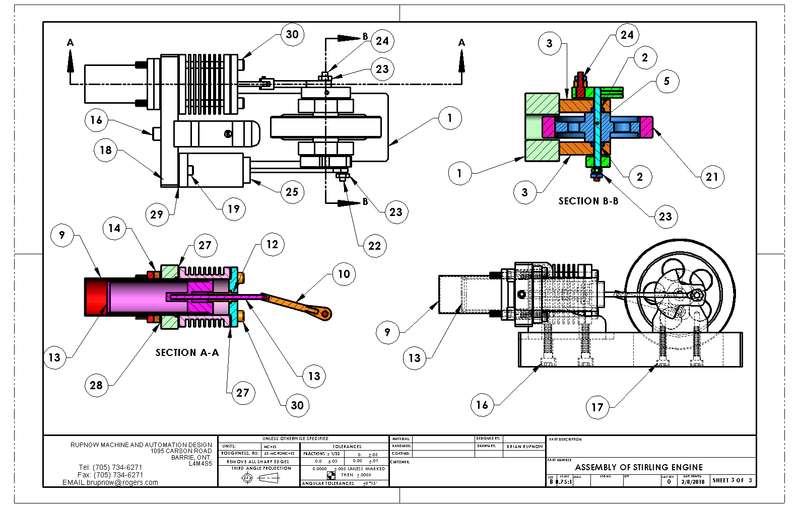You are using an out of date browser. It may not display this or other websites correctly.
You should upgrade or use an alternative browser.
You should upgrade or use an alternative browser.
Head cold from Hell and maybe a Stirling engine
- Thread starter Brian Rupnow
- Start date

Help Support Home Model Engine Machinist Forum:
This site may earn a commission from merchant affiliate
links, including eBay, Amazon, and others.
A little generator to power an LED [is it 'a led' or 'an led'?] is seen in the future . . .
fcheslop
Well-Known Member
Good luck with the water cooled version
Youre displacer keeps blowing apart due to to much heat
You could drill a small hole near the diplacer rod it wont have any effect on the running. Its often shown on other engine drawings
This engine was also my first Stirling engine and can confirm either horizontally or vertically they are sweet runners
cheers
Youre displacer keeps blowing apart due to to much heat
You could drill a small hole near the diplacer rod it wont have any effect on the running. Its often shown on other engine drawings
This engine was also my first Stirling engine and can confirm either horizontally or vertically they are sweet runners
cheers
No, the displacer piston "blew apart" because the aluminum cap wasn't a hard enough press fit into the s.s. tube. I made a new mild steel cap and silver soldered it in place, so it won't be blowing apart again.
 Does your engine which you make reference to have the big fan blade like the original Moriya plans? Does it run continuously without stopping? If it has the big fan, can you flip the fan with the engine cold and have it rotate more than one revolution?---Brian
Does your engine which you make reference to have the big fan blade like the original Moriya plans? Does it run continuously without stopping? If it has the big fan, can you flip the fan with the engine cold and have it rotate more than one revolution?---Brian
fcheslop
Well-Known Member
I no longer have Moriya it now belongs to Mr Stilldrilling I think he is on the forum
My Moria had an alloy flywheel and when turning it over you should feel slight resistance at one position or if you try to spin her you should see the engine bounce. I also fitted bronze bushes replacing the ball bearings to slow it down a bit
David is on MEM he would probably tell you about when a fan is fitted as he finished it by fitting one. I never got round to it
Still think youre flame is to hot and this is heating up the whole engine very quickly.My Moria would run for at least 1 hour when the fuel ran out
Another problem area on these engines is the displacer rubbing in the hot cap .Just worth keeping an eye out for it
Iv sent David a p,m on another forum to see if he has any video of her on utube
cheers
My Moria had an alloy flywheel and when turning it over you should feel slight resistance at one position or if you try to spin her you should see the engine bounce. I also fitted bronze bushes replacing the ball bearings to slow it down a bit
David is on MEM he would probably tell you about when a fan is fitted as he finished it by fitting one. I never got round to it
Still think youre flame is to hot and this is heating up the whole engine very quickly.My Moria would run for at least 1 hour when the fuel ran out
Another problem area on these engines is the displacer rubbing in the hot cap .Just worth keeping an eye out for it
Iv sent David a p,m on another forum to see if he has any video of her on utube
cheers
fcheslop
Well-Known Member
Found this video of my old engine by David after he fitted the fan
https://youtu.be/gipPEklfEj8
https://youtu.be/gipPEklfEj8

$49.95
$55.99
DjuiinoStar Hot Air Stirling Engine Assembly Kit: Spend 30 Minutes to Build Your Own Stirling Engine
djuiinostar
![DreamPlan Home Design and Landscaping Software Free for Windows [PC Download]](https://m.media-amazon.com/images/I/51kvZH2dVLL._SL500_.jpg)
$0.00
DreamPlan Home Design and Landscaping Software Free for Windows [PC Download]
Amazon.com Services LLC

$45.99
Sunnytech Mini Hot Air Stirling Engine Motor Model Educational Toy Kits Electricity HA001
stirlingtechonline

$99.99
AHS Outdoor Wood Boiler Yearly Maintenance Kit with Water Treatment - ProTech 300 & Test Kit
Alternative Heating & Supplies

$171.00
$190.00
Genmitsu CNC 3018-PRO Router Kit GRBL Control 3 Axis Plastic Acrylic PCB PVC Wood Carving Milling Engraving Machine, XYZ Working Area 300x180x45mm
SainSmart Official

$37.38
$49.99
Becker CAD 12 3D - professional CAD software for 2D + 3D design and modelling - for 3 PCs - 100% compatible with AutoCAD
momox Shop

$599.00
$649.00
FoxAlien Masuter Pro CNC Router Machine, Upgraded 3-Axis Engraving All-Metal Milling Machine for Wood Acrylic MDF Nylon Carving Cutting
FoxAlien Official

$26.89
$34.99
Peachtree Woodworking Supply Bowl Sander Tool Kit w/Dual Bearing Head & Hardwood Handle, 42 Pieces Wood Sander Set, 2 Hook & Loop Sanding Disc Sandpaper Assortment, 1/4 Mandrel Bowl Sander
Peachtree Woodworking Supply Inc

$19.15
$29.95
Competition Engine Building: Advanced Engine Design and Assembly Techniques (Pro Series)
MBC Inc.
Time for some "outhouse forensics" now. The Moriya fan Stirling is an exceptional design because #1--The fan is blowing (or sucking) air directly over the fins of the cold end to keep it cool in relationship to the "hot end", without blowing over the hot end to remove any heat. You can see this in a dozen different YouTube clips---the flame under the hot end doesn't even flicker.---and ---#2-the weight of the displacer piston is somewhat irrelevant, as it is operating in the vertical plane, so there is very little force on the guide bushing due to gravity. In the YouTube posts by Tubal Cain, he uses an aluminum casing off a felt pen with an extremely thin wall, which weighs less than half of the displacer piston in the Moriya. By doing this, he makes the gravity effect on the bushing as negligible as possible to provide friction free running. Instead of fins on his "hot end" he casts a very thick aluminum wall around the hot end which will act as a heat sink, which allows the engine to run much longer before the temperatures at hot and cold end equalize to stop the engine. Additionally, since he has less friction, he gets away with a smaller flame at his heat source. The only heat source I have available right now is my propane torch, but I hope to buy some solid fuel tablets or an alcohol burner later this week. Although I have no doubt that the water cooling I have designed would get the job done, I may instead go the same route as Tubal did and re-purpose an aluminum felt pen casing for my displacer cylinder. This would be about the same amount of work as a water cooling set up, with less mess. I'm learning as I go here, so be patient.
fcheslop
Well-Known Member
Hi Brian, although I can see youre reasoning the crux of the matter may well be friction as the engine simply should not need a large flame to get it running
I ran Moriya horizontally and vertically with no ill effect on performance and at that time it had a flywheel so there was no cooling from the fan
If you remove the blanking plug from the cross drilling from displacer to power piston the engine should turn with no friction or binding at any point .
My displacer was simply made by drilling into an alloy slug and a light press fitted cap and was probably a lot heavier than it should have been.
Air leaks are also a killer of these engines and its easy to find them by dunking the engine in water and turning it over
They are frustrating little beggars to make
cheers
frazer
I ran Moriya horizontally and vertically with no ill effect on performance and at that time it had a flywheel so there was no cooling from the fan
If you remove the blanking plug from the cross drilling from displacer to power piston the engine should turn with no friction or binding at any point .
My displacer was simply made by drilling into an alloy slug and a light press fitted cap and was probably a lot heavier than it should have been.
Air leaks are also a killer of these engines and its easy to find them by dunking the engine in water and turning it over
They are frustrating little beggars to make
cheers
frazer
fcheslop
Well-Known Member
Another notable point is that you are running the engine horizontally so it should run longer than when its vertical .
You can see a very simple burner running a 2inch bore engine in this video
https://youtu.be/DTqcLoUxCAg
The burner is just one of those small jam jars with a bit of stove rope for the wick .The rope is the size for sealing the glass into the door around 6mm
kind regards
You can see a very simple burner running a 2inch bore engine in this video
https://youtu.be/DTqcLoUxCAg
The burner is just one of those small jam jars with a bit of stove rope for the wick .The rope is the size for sealing the glass into the door around 6mm
kind regards
Woke up this morning with a great idea.--(No, not that kind of idea I'm 71)--I don't have a small fan to blow cooling air over the cold end cylinder on my Stirling, but I do have a great big old air compressor with enough hose to reach my office/test bench. After good wife gets up I will do some really minimalist fixturing and play a stream of air across the cold end fins while running the engine to see what happens.
I'm just down here playing on my cad station until Momma gets out of bed----I'm going to take her to work at 10:00 and then go over to Canadian tire and buy some "Meth Gell" which seems to be jellied methylated spirits in a small container to use as emergency heat source when camping.
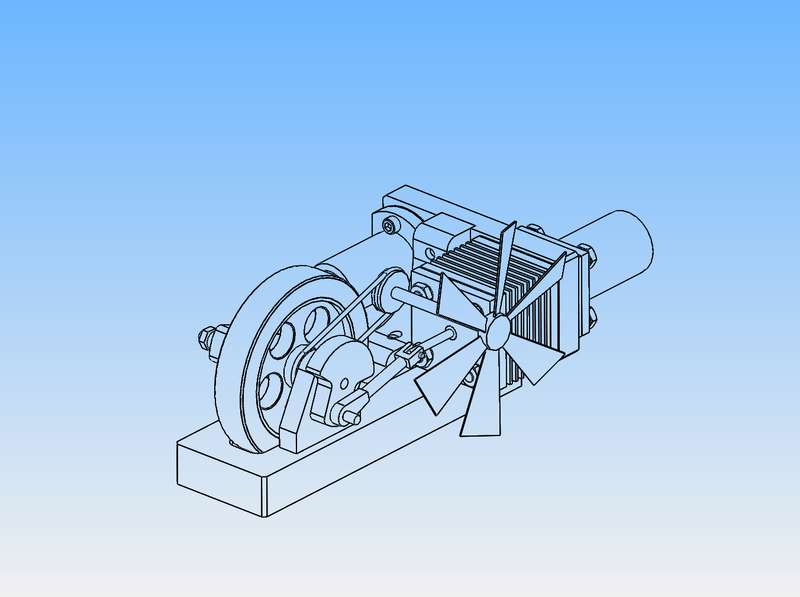

I must have done something to really anger the machine gods this morning. I picked up a can of jellied methylated spirits with the wick in the can, and set out to see if the engine would run with a lower heat source than the propane torch. The engine tried really hard to run, but never quite made it, neither in horizontal nor vertical position.---So as I am furiously spinning the flywheel by hand and muttering "Run you bastard" under my breath, I hear a crunch and everything stops. Close examination shows me that the 1/8" diameter piston displacer rod is bent. How in heck did that happen?--Pulled the displacer cylinder apart to investigate, and see that the OTHER end has pulled out of the displacer piston. Gahhhhh---What happens next!!! Okay--Quickest easiest thing to do right now is to get some weight out of that stainless displacer cylinder. It's wall is currently 0.045" thick. If I can mount it on a mandrel and take that wall down to 0.025" thick in the lathe, and work a little voodoo on that end that pulled out so it stays together, and make a new piston rod that should get me back to square 1.
In one of these pictures you can see the displacer piston in the lathe, on a mandrel. I removed .020" radially so the wall has gone from .045" down to .025" thick for weight savings. The piston was attached to the mandrel with Loctite. Believe me when I say it took seven men and a bulldog to get the mandrel out after the lathe operation. The end which had came off was aluminum, and was undamaged. I loctited the outside diameter, pressed it into place with my arbor press, then went around the circumference every 45 degrees and gave the barrel a good whack with a centerpunch and hammer to securely lock it in place with a mechanical lock.
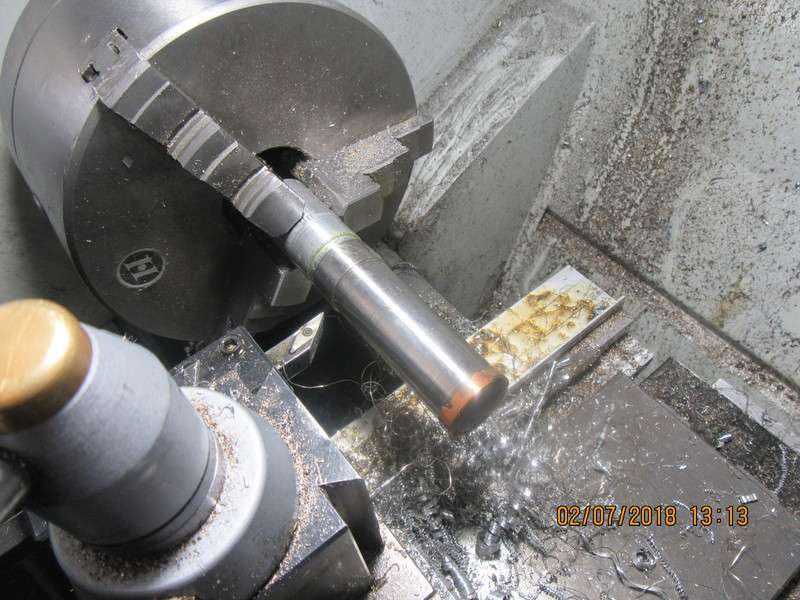
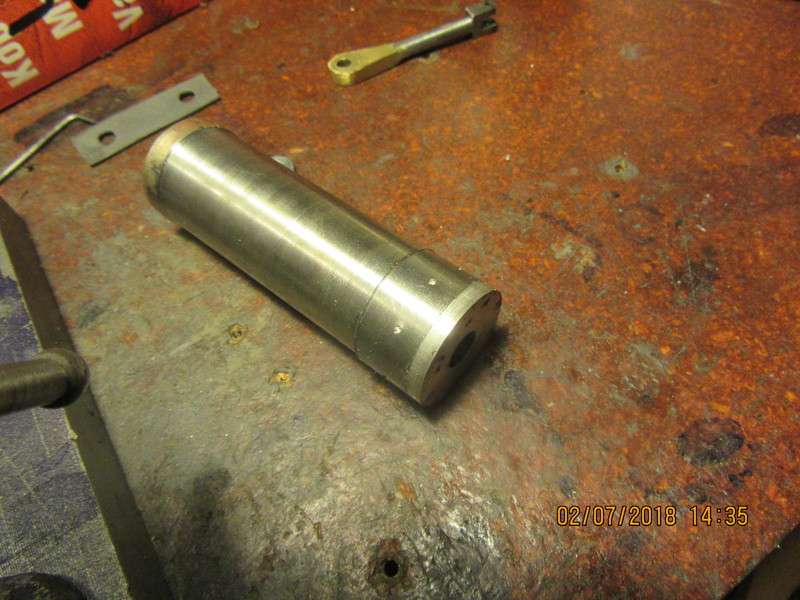


AWRIGHT!!! We have huge success!!! After reassembling the engine with a lightened displacer piston and a new piston rod, I still couldn't get it to run--even with the Propane torch. After multiple attempts and no joy, I thought "What have I got to lose" and squirted a bit of light oil on those ball bearings that I had so carefully removed the seals and grease from.--It took right off and ran like a Prince on the Propane torch. I watched it run for 10 minutes, playing a stream of air from my compressor on the cold end, then took away the propane torch and substituted a cam of jellied meth spirits. It ran another ten minutes . Then I got tired of holding my air nozzle on the displacer and quit doing that, and it ran for another ten minutes. I finally had to take the can of meth away to make it stop.
[ame]https://www.youtube.com/watch?v=jpFPORCCEXk[/ame]
[ame]https://www.youtube.com/watch?v=jpFPORCCEXk[/ame]
The engine has just passed the half hour test, running in "horizontal mode" as I had hoped for. It doesn't appear to require a cooling fan nor a water jacket. It is running from the heat from a can of "methylated spirits". At this point I am ready to declare the engine completely finished and successful. If anyone wants a complete set of updated mechanical drawings in pdf format, contact me and send $25 Canadian to my Paypal account at [email protected] There are 30 drawings, including assembly drawings and bills of material
[ame]https://www.youtube.com/watch?v=Pc8sli9XXto&feature=youtu.be[/ame]
[ame]https://www.youtube.com/watch?v=Pc8sli9XXto&feature=youtu.be[/ame]
When I was ultimately successful in a half hour horizontal run with only the methylated spirits for heat I noticed one thing and commented on it in the video. The engine would speed up and then slow down as it ran. It never quit, but the speed changes were interesting. Now after running the engine another 3 or 4 half hour runs, it is running much faster and not intermittently slowing down. I am assuming there were different "high friction" points in the linkages and bearings, that were not readily apparent to me, but were significant to this one flea power engine. The more it runs, the more these "high interference spots" get worn down until they disappear.
During the time I was building this engine and posting my progress, someone suggested that it should run with the heat from a "tea candle". I thought--"Oh sure. Maybe one of those test tube and graphite Stirlings would run on a tea candle, but not this one. It's simply too heavy for that."---Well, this morning it proved me wrong. I can hardly believe this myself.
[ame]https://www.youtube.com/watch?v=fsvoGoJUIXA&feature=youtu.be[/ame]
[ame]https://www.youtube.com/watch?v=fsvoGoJUIXA&feature=youtu.be[/ame]
Similar threads
- Replies
- 0
- Views
- 600
- Replies
- 35
- Views
- 3K




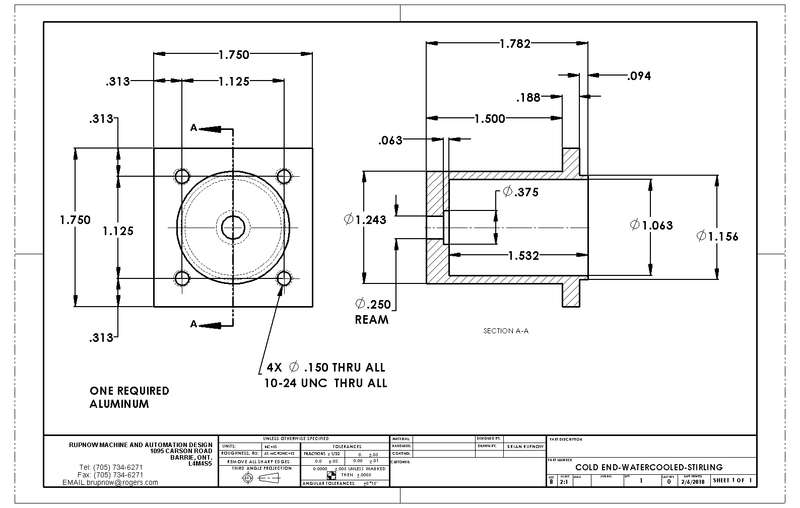
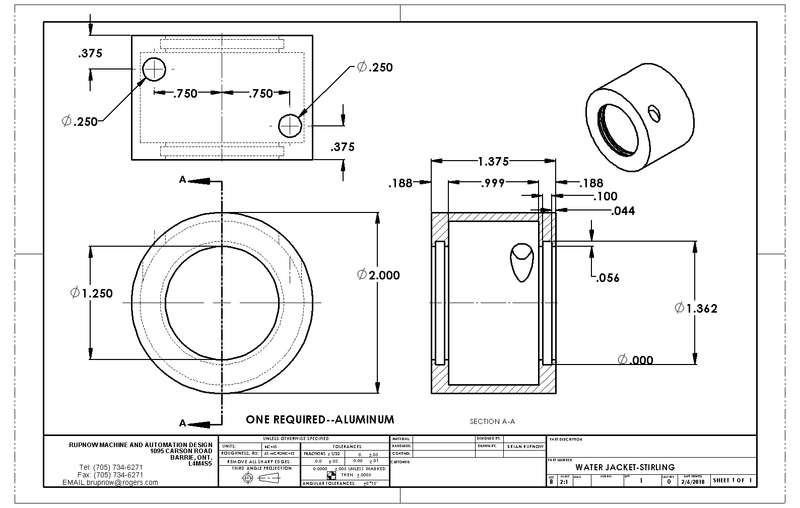


![MeshMagic 3D Free 3D Modeling Software [Download]](https://m.media-amazon.com/images/I/B1U+p8ewjGS._SL500_.png)













































